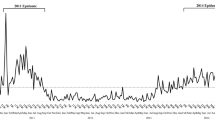Abstract
This study clinically and molecularly characterizes an adenovirus epidemic that broke out in Taiwan in April 2004. Clinical data on 325 children diagnosed with acute illness were collected between April 2004 and April 2005, and a diagnosis of adenovirus was confirmed by viral isolation. Polymerase chain reaction and restriction fragment length polymorphism were used to identify the adenovirus genotypes in 267 patients. There was a seasonal variation, with a peak incidence between November 2004 and January 2005 (p < 0.001). The median age was 52 months, range 1–210 months. Most cases (90.8%) were younger than 7 years old. Male-to-female ratio was 1.56:1. The most common clinical diagnosis was exudative tonsillitis (50.8%), followed by bronchitis/bronchiolitis (29.9%), conjunctivitis or pharyngoconjunctival fever (22.5%), and acute otitis media (16.3%). Adenovirus type 3 was found in 215 patients (80.5%). The other 52 patients had other genotypes: type 2 (10.1%), type 1 (6.0%), type 5 (1.9%), type 7 (0.7%), type 4 (0.4%), and type 6 (0.4%). Patients with type 3 were significantly older [age >52 months, adjusted odds ratio (OR) 8.55, 95% confidence interval (CI) 1.84–40, p = 0.006), their family members had a higher incidence of illness (adjusted OR 8.77, 95% CI 1.55–50, p = 0.01), they coughed (adjusted OR 6.37, 95% CI 1.54–26.3, p = 0.01), and they had a higher C-reactive protein (CRP) level (>2.87 mg/dL, adjusted OR 3.64, 95% CI 1.06–12.3, p = 0.04) than the 52 cases with other genotypes. In conclusion, this adenovirus outbreak, from late autumn to winter, was predominately caused by adenovirus type 3. Patients with this genotype were significantly older, had a higher incidence of cough and family transmission, and had higher CRP levels than those with other genotypes.


Similar content being viewed by others
Abbreviations
- PCR:
-
polymerase chain reaction
- RFLP:
-
restriction fragment length polymorphism
- ROC:
-
receiver operating characteristic
- IV-Ig:
-
intravenous immunoglobulin
- CRP:
-
C-reactive protein
- GI:
-
gastrointestinal
- LRTI:
-
lower respiratory tract infection
References
Becroft DM (1971) Bronchiolitis obliterans, bronchiectasis, and other sequelae of adenovirus type 21 infection in young children. J Clin Pathol 24:72–82
Centers for Disease Control (CDC) (1983) Adenovirus type 7 outbreak in a pediatric chronic-care facility–Pennsylvania, 1982. MMWR Morb Mort Wkly Rep 32(19):258–260
Center for Disease control (CDC), Taiwan (2007). Laboratory surveillance, Surveillance in Statistics & Analysis. http://www.cdc.gov.tw/en
Chen HL, Chiou SS, Hsiao HP, Ke GM, Lin YC, Lin KH, Jong YJ (2004) Respiratory adenoviral infections in children: a study of hospitalized cases in southern Taiwan in 2001–2002. J Trop Pediatr 50(5):279–284
Cherry JD (2004) Adenoviruses. In: Feigin RD, Cherry JD (eds) Textbook of pediatric infectious diseases 5th edn WB Saunders, Philadelphia, pp 1843–1856
Chin-Hsien T (1960) Adenovirus pneumonia epidemic among Peking infants and preschool children in 1958. Chin Med J 80:331–339
Erdman D, Xu W, Gerber S, Gray G, Schnurr D, Kajon A, Anderson L (2002) Molecular epidemiology of adenovirus type 7 in the United States, 1966–2000. Emerg Infect Dis 8:269–277
Harley D, Harrower B, Lyon M, Dick A (2001) A primary school outbreak of pharyngoconjunctival fever caused by adenovirus type 3. Commun Dis Intell 25(1):9–12
Herbert FA, Wilkinson D, Burchak E, Morgante O (1977) Adenovirus type 3 pneumonia causing lung damage in childhood. Can Med Assoc J 116:274–276
Hong JY, Lee HJ, Piedra PA, Choi EH, Park KH, Koh YY, Kim WS (2001) Lower respiratory tract infections due to adenovirus in hospitalized Korean children: epidemiology, clinical features, and prognosis. Clin Infect Dis 32:1423–1429
Kawana R, Kaneko M, Matsumoto I, Yoshida S, Kawashima K, Obara K (1966) An outbreak of pharyngoconjunctival fever due to adenovirus type 3. Jpn J Microbiol 10(3):149–157
Manoz FM, Piedra PA, Demmler GJ (1998) Disseminated adenovirus disease in immunocompromised and immunocompetent children. Clin Infect Dis 27: 1194–2000
Meadow SR, Scott DG (1985) Berger disease: Henoch-Schönlein syndrome without the rash. J Pediatr 106(1):27–32
Okano M, Thiele GM, Sakiyama Y, Matsumoto S, Purtilo DT (1990) Adenovirus infection in patients with Kawasaki disease. J Med Virol 32(1):53–57
Payne SB, Grilli EA, Smith AJ, Hoskins TW (1984) Investigation of an outbreak of adenovirus type 3 infection in a boys’ boarding school. J Hyg (Lond) 93(2):277–283
Cooper R, Hallett R, Tullo A, Klapper P (2000) The epidemiology of adenovirus infection in Greater Manchester, UK 1982–96. Epidemiol Infect 125:333–345
Yamadera S, Yamashita K, Akatsuka M, Kato N, Tokunaga M, Sakae I (2000) Adenovirus type 7 outbreaks in Japan in 1998. Jpn J Infect Dis 53: 22–23
Saito-Inagawa W, Oshima A, Aoki K, Itoh N, Isobe K, Uchio E, Ohno S, Nakajima H, Hata K, Ishiko H (1996) Rapid diagnosis of adenoviral conjunctivitis by PCR and restriction fragment length polymorphism analysis. J Clin Microbiol 34:2113–2116
Sanchez MP, Erdman DD, Torok TJ, Freeman CJ, Matyas BT (1997) Outbreak of adenovirus 35 pneumonia among adult residents and staff of a chronic care psychiatric facility. J Infect Dis 176(3):760–763
Schmitz H, Wigand R, Heinrich W (1983) Worldwide epidemiology of human adenovirus infections. Am J Epidemiol 117:455–466
Simila S, Linna O, Lanning P, Heikkinen E, Ala-Houhala M (1981) Chronic lung damage caused by adenovirus type 7: a ten-year follow-up study. Chest 80:127–131
Turner M, Istre GR, Beauchamp H, Baum M, Arnold S (1987) Community outbreak of adenovirus type 7a infections associated with a swimming pool. South Med J 80(6):712–715
Walls T, Shankar AG, Shingadia D (2003) Adenovirus: an increasingly important pathogen in paediatric bone marrow transplant patients Lancet Infect Dis 3:79–86
Wenman WM, Pagtakhan RD, Reed MH, Chernick V, Albritton W (1982) Adenovirus bronchiolitis in Manitoba: epidemiologic, clinical, and radiologic features. Chest 81:605–609
Wesley AG, Pather M, Tait D (1993) Nosocomial adenovirus infection in a paediatric respiratory unit. J Hosp Infect 25:183–190
Author information
Authors and Affiliations
Corresponding authors
Rights and permissions
About this article
Cite this article
Cheng, CC., Huang, LM., Kao, CL. et al. Molecular and clinical characteristics of adenoviral infections in Taiwanese children in 2004–2005. Eur J Pediatr 167, 633–640 (2008). https://doi.org/10.1007/s00431-007-0562-4
Received:
Revised:
Accepted:
Published:
Issue Date:
DOI: https://doi.org/10.1007/s00431-007-0562-4




